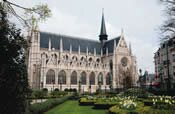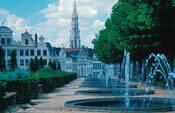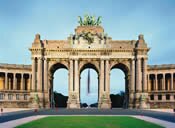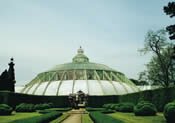Inflight Magazine of Brussels Airlines
Welcome to the Inflight Magazine of Brussels Airlines
Let’s go outside
Images Alamy
Spring is well and truly sprung in the Belgian capital, so where should you head to make the most of it? With parks littering Brussels’ urban topography in the best possible way, Guy Dittrich discovers it’s easy being green
 The battle for the Brussels ‘green lung’ crown is fought between the most central of its parks – the appropriately named Parc de Bruxelles – and the Bois de la Cambre to the south of the city. Both have seen bloodshed; the former was the battleground of Belgian patriots and Dutch troops in the revolution of 1830, while the latter was the hunting ground of the Dukes of Brabant. For sheer size, however, the Bois de la Cambre takes the title, with 120-odd hectares that run southward into the Forêt de Soignes where, urban myth has it, you can get all the way to Paris through the woods.
The battle for the Brussels ‘green lung’ crown is fought between the most central of its parks – the appropriately named Parc de Bruxelles – and the Bois de la Cambre to the south of the city. Both have seen bloodshed; the former was the battleground of Belgian patriots and Dutch troops in the revolution of 1830, while the latter was the hunting ground of the Dukes of Brabant. For sheer size, however, the Bois de la Cambre takes the title, with 120-odd hectares that run southward into the Forêt de Soignes where, urban myth has it, you can get all the way to Paris through the woods.
In a city better known for its grey, late-20th-century towers and a mismatch of architectural styles, one thing the town planners did manage to get right was the green spaces. It may not seem like it when you’re in the midst of less salubrious neighbourhoods such as Anderlecht and the Marolles, but Brussels is a very green city. While a stroll along the city streets usually gives the appearance of a purely built environment, a quick look up an alleyway or into an entrance will often offer up an incredible mature garden, and the briefest of fly-bys on Google Maps reveals courtyards full of trees. This is a Brussels ‘secret’ that residents either don’t realise just how fortunate they are to have, or typically keep to themselves.
Beauty in order
 Starting in the middle, just up the cobbled streets from the Grand’Place and a few minutes’ walk from the Parc de Bruxelles, is the small jewel of Place du Petit Sablon. Here you’ll find a perfectly tended patch of planted beds and cropped hedges ringed with art nouveau railings and columns by Paul Hankar, each topped with a delicate statue representing one of Brussels’ 48 ancient guilds. Across the street, meanwhile, reached through an arched carriageway, is the hidden sward of Egmont Park, complete with Peter Pan statue.
Starting in the middle, just up the cobbled streets from the Grand’Place and a few minutes’ walk from the Parc de Bruxelles, is the small jewel of Place du Petit Sablon. Here you’ll find a perfectly tended patch of planted beds and cropped hedges ringed with art nouveau railings and columns by Paul Hankar, each topped with a delicate statue representing one of Brussels’ 48 ancient guilds. Across the street, meanwhile, reached through an arched carriageway, is the hidden sward of Egmont Park, complete with Peter Pan statue.
Even closer to the Grand’Place and in the heart of the museums quarter is the formal park of the Monts des Arts. Taggers used to sprayed graffiti on the hedgerows here, but it’s benefited from a recent sprucing up. More orderly gravel paths and rows of plane trees than emerald lawns, this park boasts great views from its steps to the tower of the Grand’Place, the Koekelberg Basilica and, on a clear day, even the Atomium.
The orderliness of Monts des Arts continues in the city’s central parks. The Parc de Bruxelles sees lunchtime joggers looping around paths laid out on the basis of various Masonic symbols – most obviously a pair of dividers – while further Masonic symbolism can be discovered in the park’s statues and their inscriptions. At nearby Parc du Cinquantenaire, meanwhile, there’s the first part of King Léopold II’s grand avenue that leads towards Tervuren (and the museum where the ill-gotten gains of his raids in the Congo are exhibited). The Cinquantenaire is a classic park, dominated by the triumphal arch built in 1880 to celebrate 50 years of Belgian independence. The wings of the building are home to Royal museums of art and history, military and aviation history, and motor vehicles.
Noble lineage
 If you venture further out to Tervuren Park – beyond the city limits but easily reached by a tram that rattles past the hills and lakes of Parc de Woluwé and through the Forêt de Soignes – you’ll enjoy beautiful gardens and lakes laid out in a Louis XVI style, leading up to the imposing length of the Africa Museum, that’s designed in the characteristically overblown, neo-classical look favoured by Léopold II.
If you venture further out to Tervuren Park – beyond the city limits but easily reached by a tram that rattles past the hills and lakes of Parc de Woluwé and through the Forêt de Soignes – you’ll enjoy beautiful gardens and lakes laid out in a Louis XVI style, leading up to the imposing length of the Africa Museum, that’s designed in the characteristically overblown, neo-classical look favoured by Léopold II.
Keeping with the Royals, the vast green suburb of Laeken to the north of the city is the site of their official residence. A short walk from the sparkle of the Atomium, next to the Royal Palace, are the Royal Greenhouses – or Serres Royales – built with the cutting-edge technology of the late 19th century. These vast steel and glass pavilions are worth visiting as much for their architecture as their botanical treasure. The King opens them to the public for a few weeks each spring in order that we might witness the enormous palms, some dating from his original collection, and the new season’s flowers – particularly rare camellias, geraniums and azaleas.
The aforementioned Forêt de Soignes, Brussels’s real green lung, spreads south from Tervuren and can be seen in a loose arc of ‘pocket parks’ ranging to the west. In the southwestern commune of Forest (the clue is in the name) are two parks that are vestiges of de Soignes.
Somewhat inappropriately named, Parc de Forest is largely an orderly lawn, while Duden Park is much more of a wild forest of trees, covering the steep valleys of this small suburban treasure.
Island hideaway
 The most popular and accessible part of the Forêt de Soignes is the Bois de la Cambre, found at the southern end of Avenue Louise, which cuts through the suburb of Ixelles. Closed to traffic on Sundays (but sadly encircled by roaring cars the rest of the time), Bois recently received a face lift, with walkways repaired and ponds cleaned up. The wooded northern section of the park focuses on a steep-sided ravine, crossed by recently reopened stone footbridges, and hides a magical little auberge, Woods. Adjacent are the more open lawns sloping down to the lake and a born-again island retreat, Chalet Robinson. Reopened last autumn almost two decades after being engulfed in flames, this all-day restaurant-cum-café is reached by a quaint but efficient new ferry system. It’ll no doubt be popular as the weather improves, so book ahead.
The most popular and accessible part of the Forêt de Soignes is the Bois de la Cambre, found at the southern end of Avenue Louise, which cuts through the suburb of Ixelles. Closed to traffic on Sundays (but sadly encircled by roaring cars the rest of the time), Bois recently received a face lift, with walkways repaired and ponds cleaned up. The wooded northern section of the park focuses on a steep-sided ravine, crossed by recently reopened stone footbridges, and hides a magical little auberge, Woods. Adjacent are the more open lawns sloping down to the lake and a born-again island retreat, Chalet Robinson. Reopened last autumn almost two decades after being engulfed in flames, this all-day restaurant-cum-café is reached by a quaint but efficient new ferry system. It’ll no doubt be popular as the weather improves, so book ahead.
The true beauty of the Forêt de Soignes, however, is revealed only to those who venture further south, deep into the woods. Here gravel paths and horse tracks crisscross the undulating landscape, thick with trees. Long and straight, the paths present some magnificent vistas of sturdy yet statuesque beech trees marching away with military precision into the distance. Beyond are thickets and glades so dense that it’s hard to believe you’re so close to the metropolitan area. A huge boost to quality of life in the city, the most amazing thing about the Forêt de Soignes is how empty it is, even at weekends. This is a piece of park life worth devoting your heart to.
Parc de Bruxelles rux
Promenade to your heart’s content along the formal paths and among the statues and fountains of this park fronting the Royal Palace
Place du Petit Sablon
Enjoy a break from the high-end shops of Grand Sablon with a box of chocolates from Pierre Marcolini or Wittamer beside the fountain and flowers of Petit Sablon
Egmont Park
With entrances that are tricky to find, this is a great example of the hidden green spaces to be discovered across the city
Parc de Forest
More a lawn than a forest, this park is busy all day in summer
Gardens Van Buuren
The modest fee (€5) is worth it for the gardens, complete with maze, and there’s also an art deco masterpiece to visit: www.museumvanbuuren.com
Duden Park
More a forest than a park, this is an amazing find so close to the city
Royal Greenhouses
The greenhouses are open for a few weeks each spring only, but the gardens surrounding the Royal Palace include two of Léopold II’s follies – the Chinese Pavilion and the Japanese Tower – which are now exhibition spaces: www.monarchie.be
Parc du Cinquantenaire
Symmetrical pathways, laurel and bay hedges and sweeping lawns provide a surprising break from the traffic and claustrophobia of the EU quarter
Ixelles Ponds
The ‘Keep Off’ signs on the narrow strip of lawn surrounding the ponds are largely ignored when the sun shines
Bois de la Cambre
Walk off lunch at the restaurants Woods or Chalet Robinson with a stroll around this beautiful park
Forêt de Soignes
The granddaddy of Brussels’ parks requires that you keep your bearings: it’s a big wide wood out there!
Tervuren Park
The formal gardens that step down from the Africa Museum extend into a more park-like setting of lawns and ponds
Ferme du Parc Maximilien
A real farm in the heart of the city that’s great for kids of all ages: fermeduparcmaximilien.be
FR Allons dans les bois…
Le printemps, dans la capitale belge, est une période vraiment énergétique. Mais où aller pour en profiter pleinement ? Avec des parcs qui couvrent largement la topographie urbaine de Bruxelles, Guy Dittrich découvre combien il est facile de se mettre au vert.
Bruxelles est sans doute mieux connue pour ses tours grises de la fin du 20ème siècle et ses styles architecturaux éclectiques, mais en réalité c’est une ville verte.
Prenez comme point de départ le centre de la ville. En remontant de la Grand-Place, vous atteignez la Place du Petit Sablon. Traversez la rue qui lui fait face, où se trouve le Parc d’Egmont, avec ses parterres parfaitement entretenus et ses haies bien taillées, entouré de grilles Art nouveau. Plus proche encore de la Grand-Place, le Parc du Mont des Arts, offre de magnifiques vues sur les tours de la Grand-Place et par temps clair, sur l’Atomium.
Le Parc de Bruxelles voit défiler les joggeurs à l’heure du déjeuner, ceux-ci circulent autour des allées dessinées selon un schéma qui intègre des symboles maçonniques. Non loin, le Parc du Cinquantenaire est un des premiers projets d’aménagements du roi Léopold II, le long de la grande avenue menant à Tervueren (on y accède en tram et l’endroit comprend de somptueux jardins de style Louis XVI). Pour rester dans la royauté, Laeken est le site de la résidence officielle de la famille royale belge, qui comprend également les Serres Royales. Chaque printemps, le roi les ouvre au public, et elles méritent une visite autant pour leur architecture que pour leurs trésors botaniques.
Mais le vrai poumon vert de Bruxelles est la Forêt de Soignes, et le Bois de la Cambre, sa partie la plus accessible au sud d’Ixelles. La partie nord de ce bois apparaît comme un vallon encaissé, sillonné par des chemins de pierres, tandis que de vastes prairies descendent vers un lac sur lequel est posé une petite île. Pour apprécier la vraie beauté de la Forêt de Soignes, vous devez toutefois vous aventurer plus profondément dans les bois, où les fourrés sont si denses qu’il est parfois difficile de croire que vous êtes si proche de la métropole. Et chose étonnante est de constater à quel point l’endroit est désert, même les week-ends.
NL Een frisse neus halen in de lentezon
De lente is eindelijk met grote trom in de Belgische hoofdstad aangekomen. En daar gaan we met volle teugen van genieten! Brussel ligt bezaaid met parken, Guy Dittrich ontdekt de geneugten van al dat groen
Brussel mag dan wel beter gekend zijn voor z’n grijze torens uit de late 20e eeuw en z’n bonte mengeling van architecturale stijlen, maar het is ook een erg groene stad.
In het hart van de hoofdstad, vlak bij de Grote Markt, ligt de Kleine Zavel. Hier worden perfect gesnoeide perken en hagen omsloten door art nouveau traliewerk. Aan de overkant van de straat ligt het Egmont Park en nog dichter bij de Grote Markt vind je het park van de Kunstberg. Van daaruit heb je een prachtig uitzicht op de toren van de Grote Markt en, op heldere dagen, een vergezicht van het Atomium.
In het centraal gelegen Warandepark lopen rond lunchtijd heel wat joggers hun dagelijkse rondjes op de paden op langs vrijmetselarijsymbolen. In het nabijgelegen Jubelpark begint het eerste deel van de grote laan van koning Leopold II richting Tervuren (bereikbaar met de tram, langs prachtige tuinen in de stijl van Louis XVI). Hoog bezoek in Laken, waar de koninklijke familie woont en de Koninklijke Serres liggen. De koning opent elke lente plechtig de serres, die absoluut een bezoek waard zijn, zowel voor de architecturale pracht als voor de botanische rijkdom die erin huist.
De echte groene long van Brussel is het Zoniënwoud, dat het best toegankelijk is via Ter Kamerenbos, ten zuiden van Elsene. Het bosrijke noordelijke gedeelte heeft een opvallende steile ravijn met stenen voetgangersbruggen en de aangrenzende open grasvelden reiken tot helemaal beneden aan het meer met een eilandje erin. Om de ware pracht van het Zoniënwoud te ontdekken, moet je echter dieper het bos is. Het kreupelhout en het struikgewas groeit er zo dicht dat je amper gelooft dat je je vlak bij een metropolis bevindt. Het opvallendste kenmerk van allemaal? Het is er bijna altijd leeg en rustig, zelfs in het weekend.
Leave a Reply
